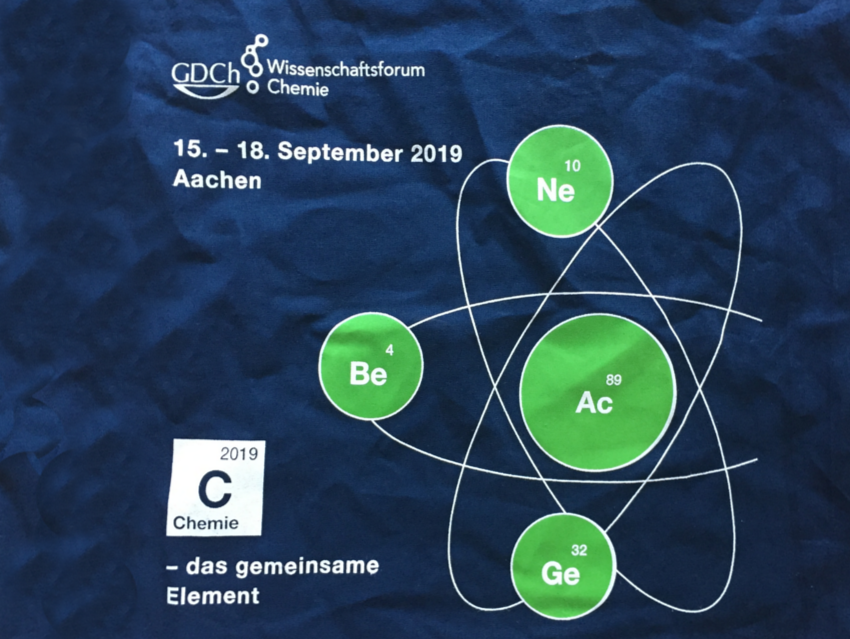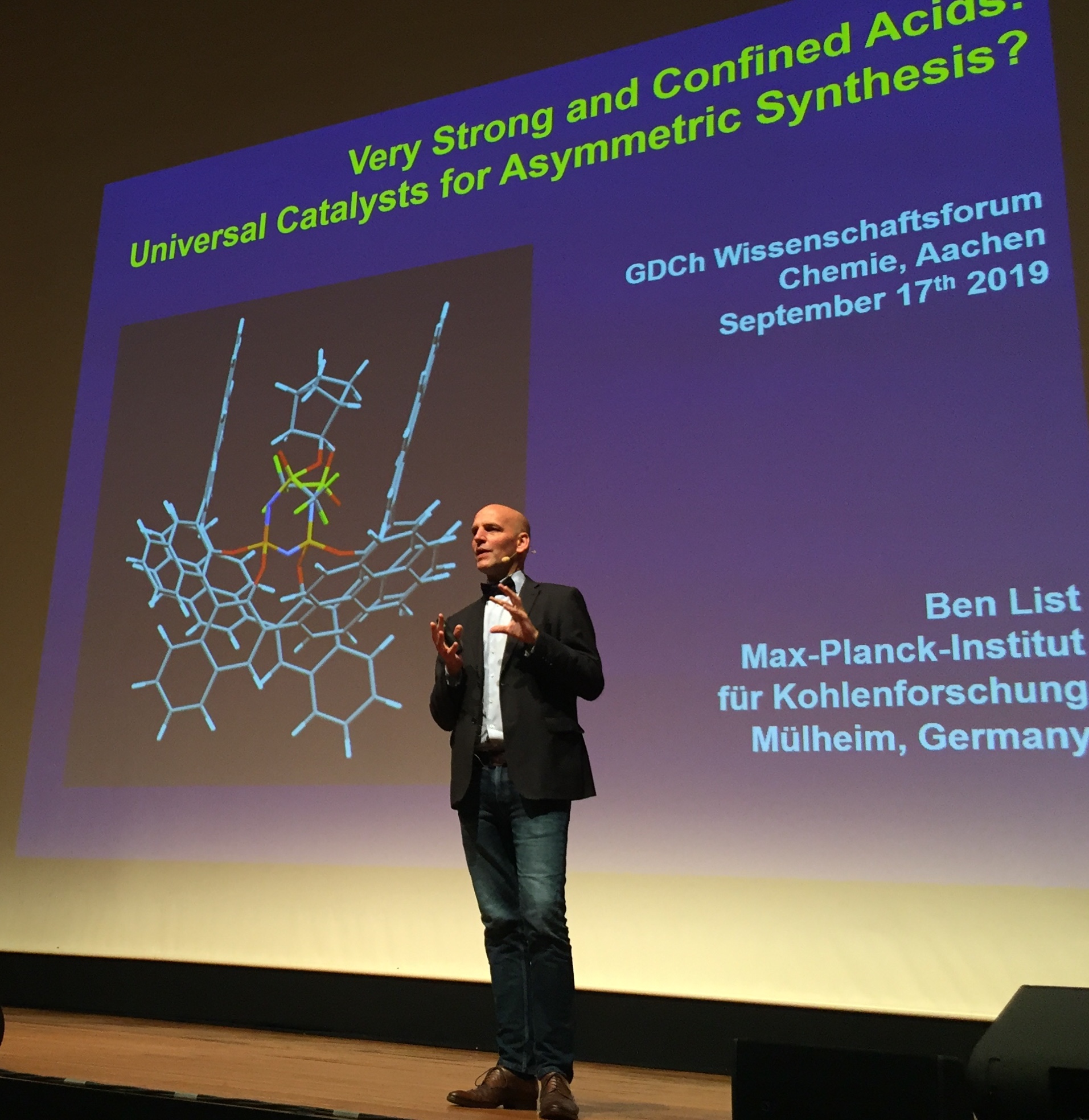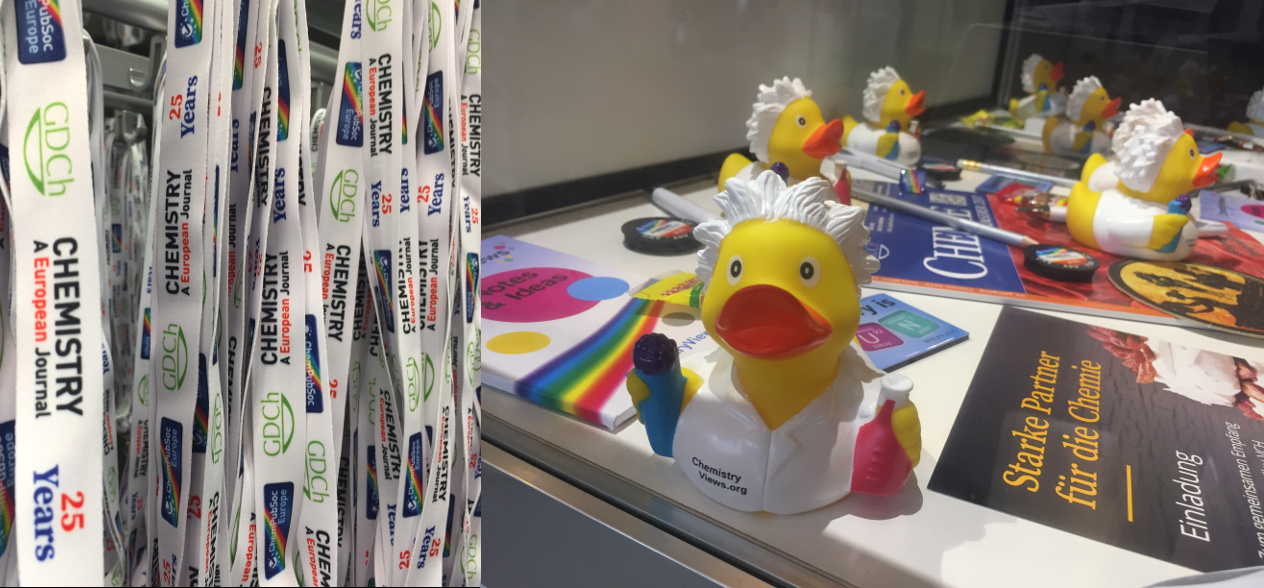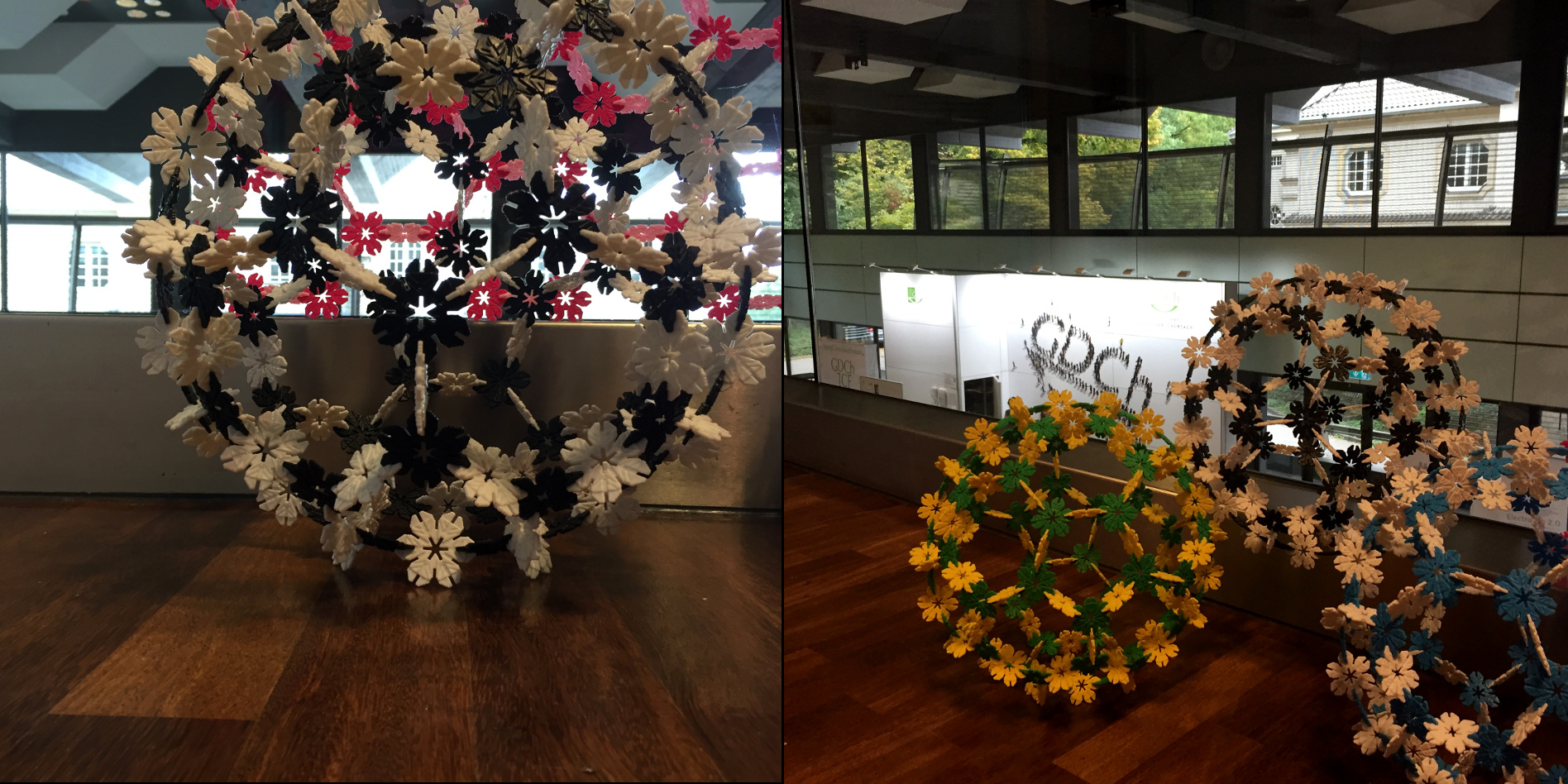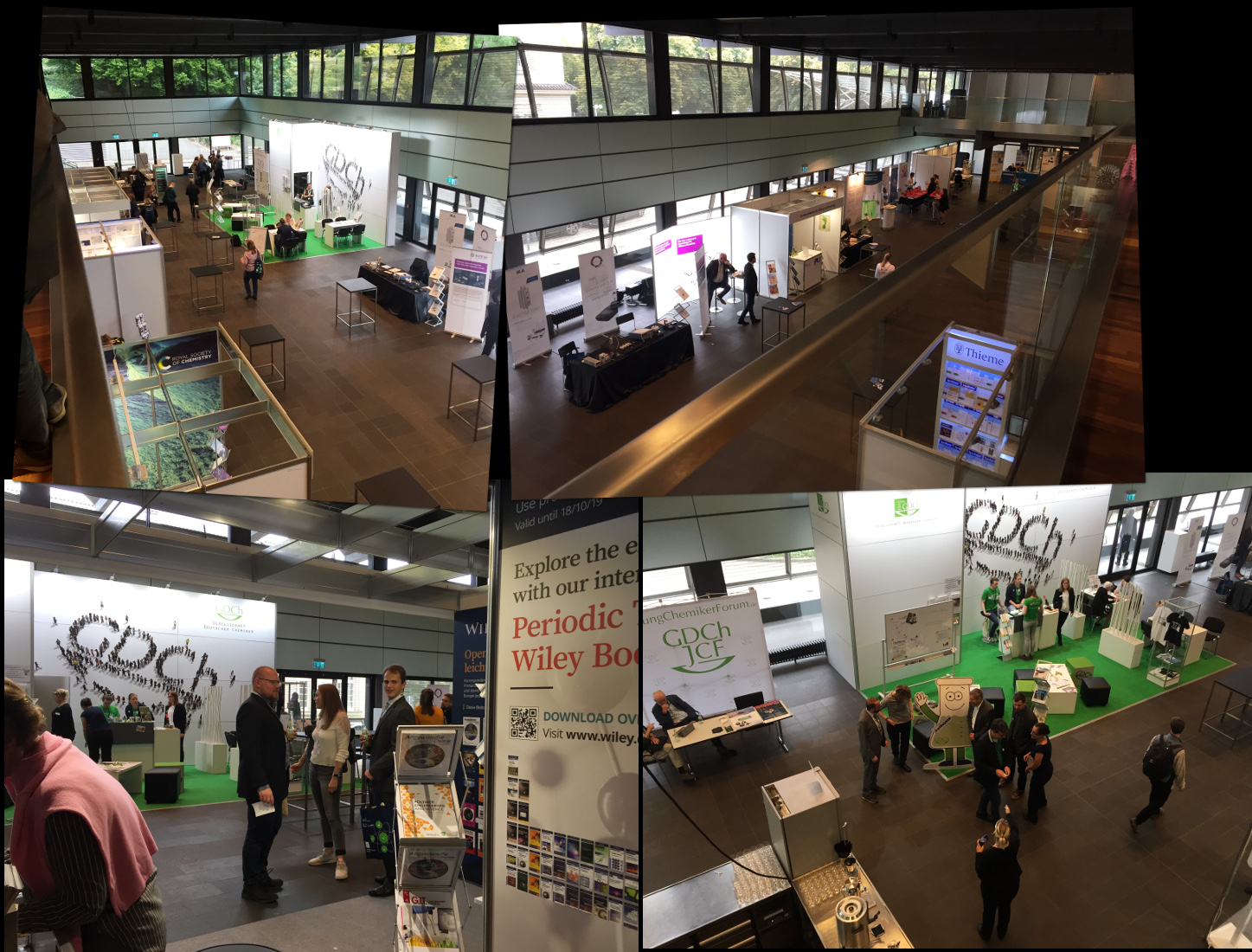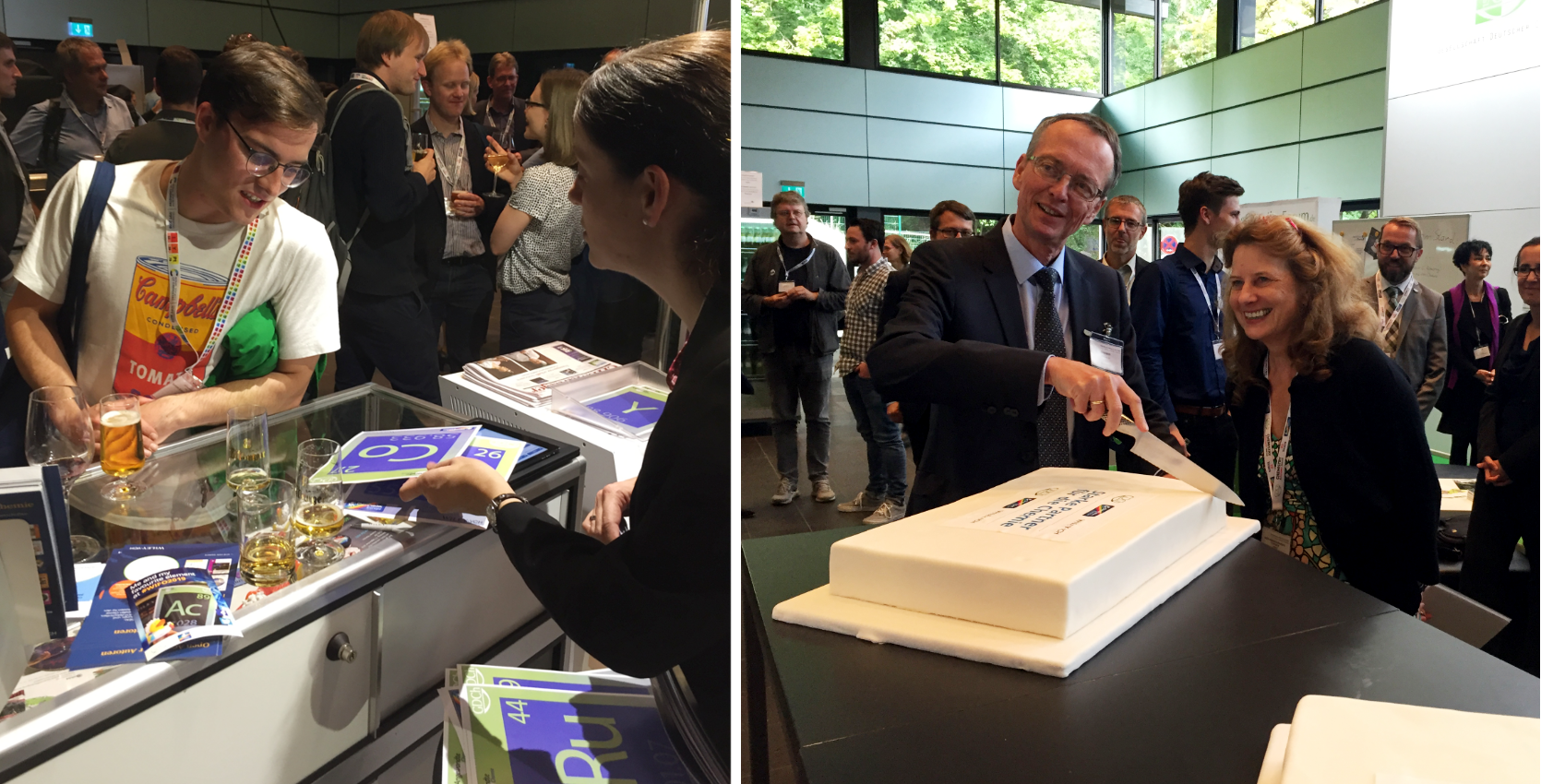The Science Forum Chemistry (Wissenschaftsforum), or WiFo for short, is the most important chemistry congress in the German-speaking world. It is organized every two years by the German Chemical Society (GDCh). Under the motto “Chemistry – The Essential Element” chemists from Germany, Belgium, and The Netherlands met from September 15 to 18 at the Eurogress in Aachen. This time the Royal Flemish Chemical Society (KVCV) and the Royal Netherlands Chemical Society (KNCV) were co-organizers of the conference. Professor Dominik Wöll, RWTH University Aachen, was chairman of the local organizing committee.
Each day was dedicated to a different topic: Fascination Chemistry, Molecular Design, Resource and Sustainability Issues in Chemistry. Scientific lectures and posters were accompanied by symposia of the GDCh divisions, a chemistry slam, a founder’s workshop, a panel discussion on “Quo Vadis Industry 4.0”, a job fair, a trade exhibition, and much more, as well as many opportunities for exchange and networking.
Of course, the International Year of the Periodic Table (IYPT2019), proclaimed by UNESCO and the United Nations General Assembly, had a special significance this year. This can already be seen from the conference logo (pictured above), as well as from activities at exhibition stands such as complete a periodic table as fast as possible or take a picture with your favorite element.
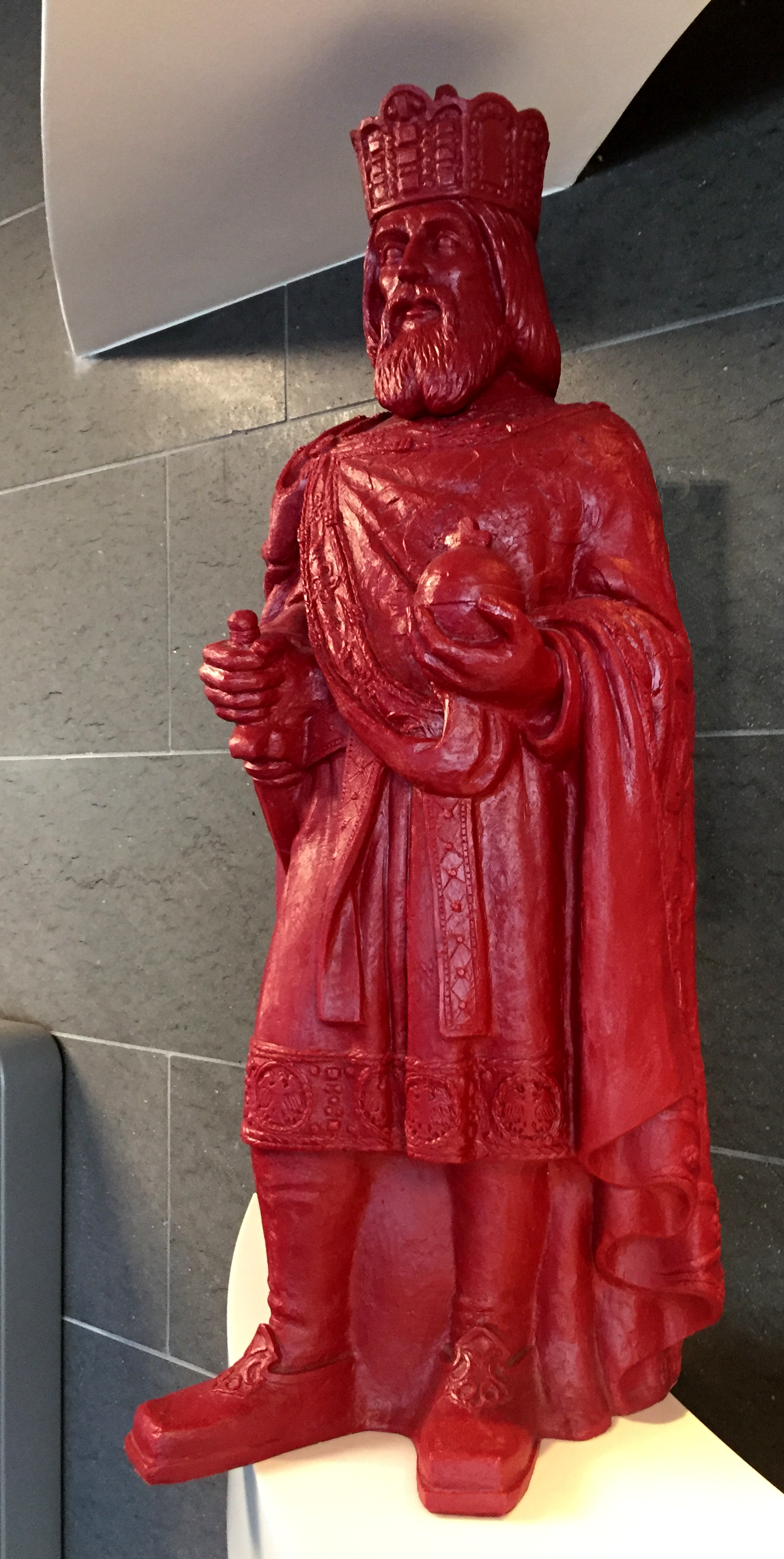 |
|
Figure 1. About 1200 years ago Aachen was the center of power in Europe under Charlemagne or Charles the Great. |
Among the international guests were Professor Kyoko Nozaki, University of Tokyo, Japan, who was awarded the August Wilhelm von Hofmann lectureship, Professor Pilar Goya Laza, President of EuChemS (European Chemical Society) and Instituto de Química Médica (IQM), Madrid, Spain, Professor Peter Dorhout, Past-President of the American Chemical Society (ACS) and Kansas State University, USA, as well as two delegates of the Korean Chemical Society (KCS). These were Professor Eunsung Lee, Pohang University of Science and Technology, Republic of Korea, who gave a lecture in the inorganic chemistry session, and Professor Seung Bum Park, Seoul National University, Republic of Korea, who presented his research at the organic chemistry session. The GDCh has entered into bilateral cooperation agreements with several chemical societies outside of Germany. Such agreements set the parameters of cooperation, with various advantages for the members of both societies. KCS and GDCh formed a Bilateral Collaboration Alliance in 2012.
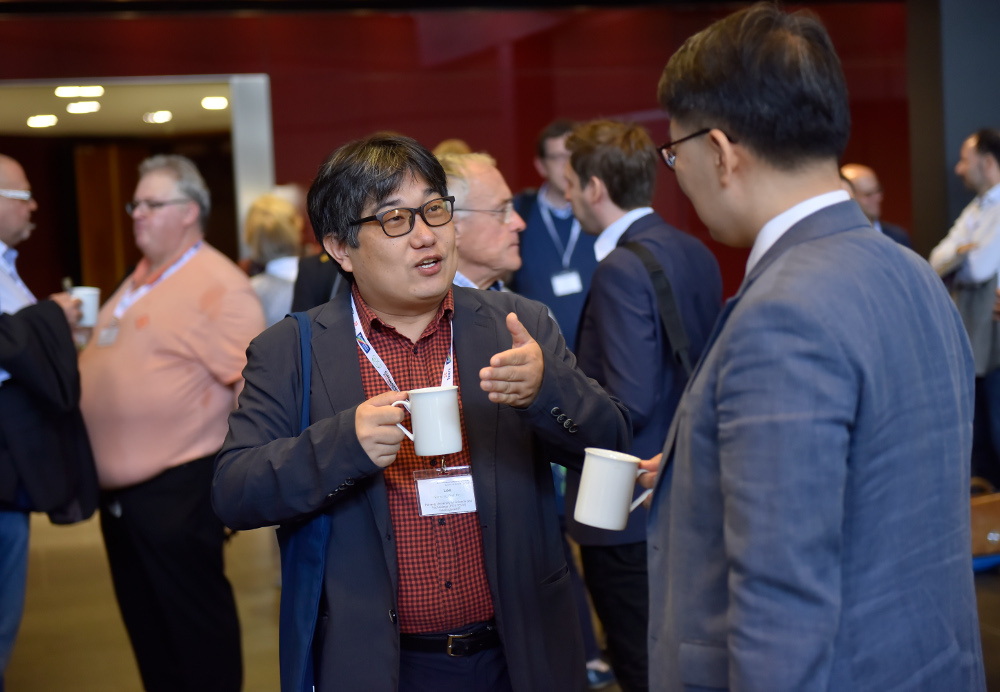
Figure 2. Professor Eunsung Lee (left), Pohang University of Science and Technology, Republic of Korea, and Professor Seung Bum Park, Seoul National University, Republic of Korea, during a coffee break. (Photo: © GDCh/Christian Augustin)
Opening Ceremony
Taking Responsibility in Society
Dr. Matthias Urmann, President of the GDCh and Sanofi-Aventis Deutschland GmbH, Frankfurt am Main, opened the conference with a plea for volunteer work and a strong stance not only on the current state of research but also on important topics from society. Urmann appealed that the advocacy against so-called fake news is an important task for scientists and scientific societies. Exact and reliable science – instead of acting on emotions and relying on one’s gut feeling – is essential for our modern society.
Matthias Urmann suggested that we chemists think about what we and what chemistry can and must do for future generations. Planting heat-tolerant trees is not the solution to climate problems. We must ask politicians uncomfortable questions, make our knowledge available, admonish politicians until all countries have reached a minimum consensus, etc. As scientists, we depend on international cooperation. We need open discourse and we must take a firm stand against xenophobia.
Our tasks as scientists are becoming more diverse and go beyond science. As members of the GDCh, we agree with the GDCh’s Code of Conduct. In the code, it says: “The GDCh commits itself and its members to stand up for freedom, tolerance, and truthfulness in science, in particular, to preserve and increase the reputation of chemistry as well as chemical knowledge and skills. All GDCh members are aware that as scientists they are particularly responsible for the effects of their professional activities on humans and nature. The GDCh and its members support and promote sustainable development in society, economy, and environment. They always act in the awareness of their responsibility towards future generations”. [1]
Voluntary commitment in a chemical society like the GDCh takes time and time is becoming increasingly scarce. Matthias Urmann appealed that employees should be given time for this because not only we ourselves but also society as a whole benefit from this. Urmann concluded with the hopes that everyone will go home from this conference strengthened, motivated, and with many new ideas.
Element Games
Professor Floris Rutjes, Vice President of KNCV and Radboud University, The Netherlands, looked out for appropriate elements for a welcome: Re is named after the river Rhine. It connects the Netherlands and Germany. Ac can represent the city of Aachen. Cars in Aachen have Ac on their number plate. Ti is strong, light, and does not easily corrode. It symbolizes the cooperation of the three societies GDCh, KNCV, and Royal Flemish Chemical Society (KVCV). O and N are crucial to life. This gives ReAcTiON which, of course, is vital for all chemists. Enthusiastic reactions drive innovation, and social interactions make these days in Aachen useful, Floris Rutjes concluded.
Professor Eric Schouteden, Vice President of the Royal Flemish Chemical Society (KVCV), Belgium, got inspired by the conference logo for his talk. Ge from germania, Latin for Germany, appears mostly in low concentration and thus was discovered comparatively late. In 1869, Dmitri Mendeleev predicted its existence and some of its properties from its position on his periodic table. He called the element eka silicon. Only in 1886, Clemens Winkler found Ge along with silver and sulfur and Mendeleev’s predictions that the element is a relative of silicon could be confirmed.
Ge is always found in combination with other elements. However, Eric Schouteden jokingly pointed out in his speech, the GDCh is the first to successfully react Ne(therlands) and Be(lgium) with Ge(rmany).
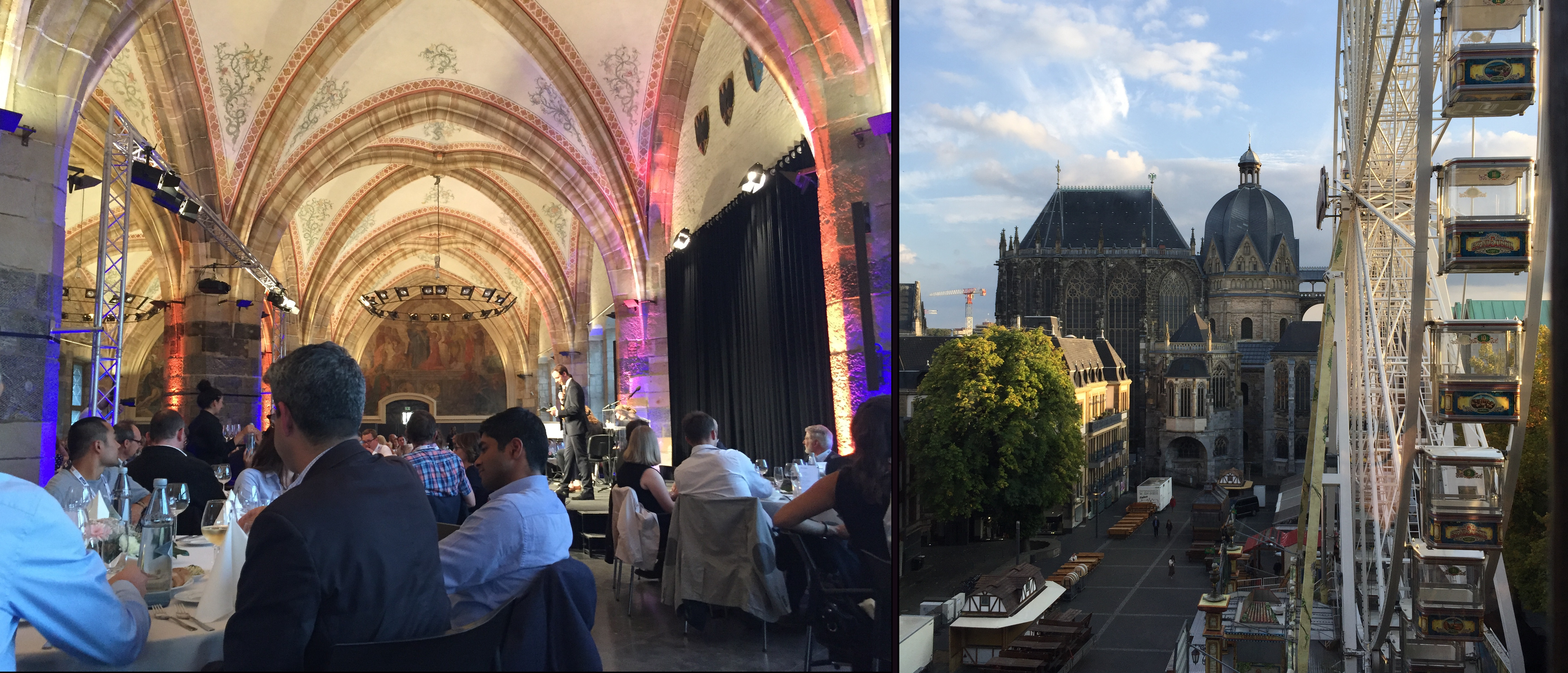
Figure 3. The conference dinner took place in the coronation hall of the Aachen Town Hall (left). View from the town hall to the cathedral (right). Fotos: © Vera Koester
Selected Talks
Universal Catalysts for Asymmetric Synthesis
“There is no more fascinating topic to think about than catalysis. Catalysis is the enabling technology, or do you know anything else that contributes to over 1/3 of the global domestic product?” Professor Benjamin List, Max Planck Institute for Coal Research, Mülheim an der Ruhr, started his talk. He explained that Lewis acid catalysis is the single most established approach of catalysis, the most powerful approach to catalysis, and the most general approach. Acid catalysis enables key transformations, such as the Diels–Alder and Friedel–Crafts reactions, and various aldol, Mannich, and Michael reactions.
When it comes to enantioselective Lewis acid catalysis, very nice catalysts have been developed. This chemistry, however, for some reason never made it into industrial processes. “There probably is a fundamental design flaw in how we make these catalysts.”, Ben List concluded. A key limitation of enantioselective Lewis acid catalysis is the frequent need for relatively high catalyst loadings (10–20 mol%). This results from issues such as insufficient Lewis acidity, product inhibition, hydrolytic instability, and background catalysis.
To solve this problem, List and his group have removed the ligand entirely and put the chirality onto the counter ion. By this, they hope to tailor the dramatic reactivity of AlCl3 or similar acids in activating a Lewis base substrate and still achieve high enantioselectivity. In addition, there is no covalent kind of mechanism anymore, instead, a counterion by ion-pairing reduces the symmetry in a transformation that occurs with an activated substance. For such an asymmetric counteranion-directed catalysis (ACDC), the group has designed silylated organic acids. Silylation of an electrophile generates a cationic reactive species that ion-pairs with an enantiopure counteranion and reacts with a silylated nucleophile [12].
Using this approach, Ben List has developed extremely active organic Lewis acid catalysts that allow asymmetric versions of challenging Diels–Alder reactions. These confined acids allow the use of small and unbiased substrates and, because of their high acidity, the activation of previously inaccessible substrates for organocatalysis. List, together with his team, is currently expanding this silylium-ACDC concept to, in principle, all types of Lewis acid-catalyzed reactions, including those that do not involve silylated reagents.
Gummy Bears and Reductive Splitting of Azo Dyes in Chemistry Education
Professor Matthias Ducci, Pädagogische Hochschule (PH) Karlsruhe, uses the reductive cleavage of azo dyes as an example to demonstrate a newly developed concept in chemistry education. The context of a subject is broken down into its facets, experiments are developed under consideration of didactic principles, and the subject is translated into concrete, motivating problems. A reference to everyday life is important.
The starting point of Matthias Ducci’s experimental lecture was the splitting of Brilliant Black BN from gummy bears. Ducci proved that his concept not only fascinates students. Also, the conference visitors were excited by the colorful gummy bears, quick experiments, and a clever combination of facts [2–5].
Azo dyes are contained in many everyday products. Only a few are approved for food, such as Brilliant Black, also known as E 151. In the human body, azo dyes can be reductively split into aromatic amines at the azo group. This can happen, e.g., by intestinal bacteria or by azoreductases of the liver. Certain aromatic amines have carcinogenic potential. Nevertheless, azo dyes banned in the EU are repeatedly found in imported foods and other everyday products. For example, questionable azo dyes are added to spices to cover up that they are no longer fresh. The reductive cleavage of azo dyes also plays a role in the laser removal of tattoos.
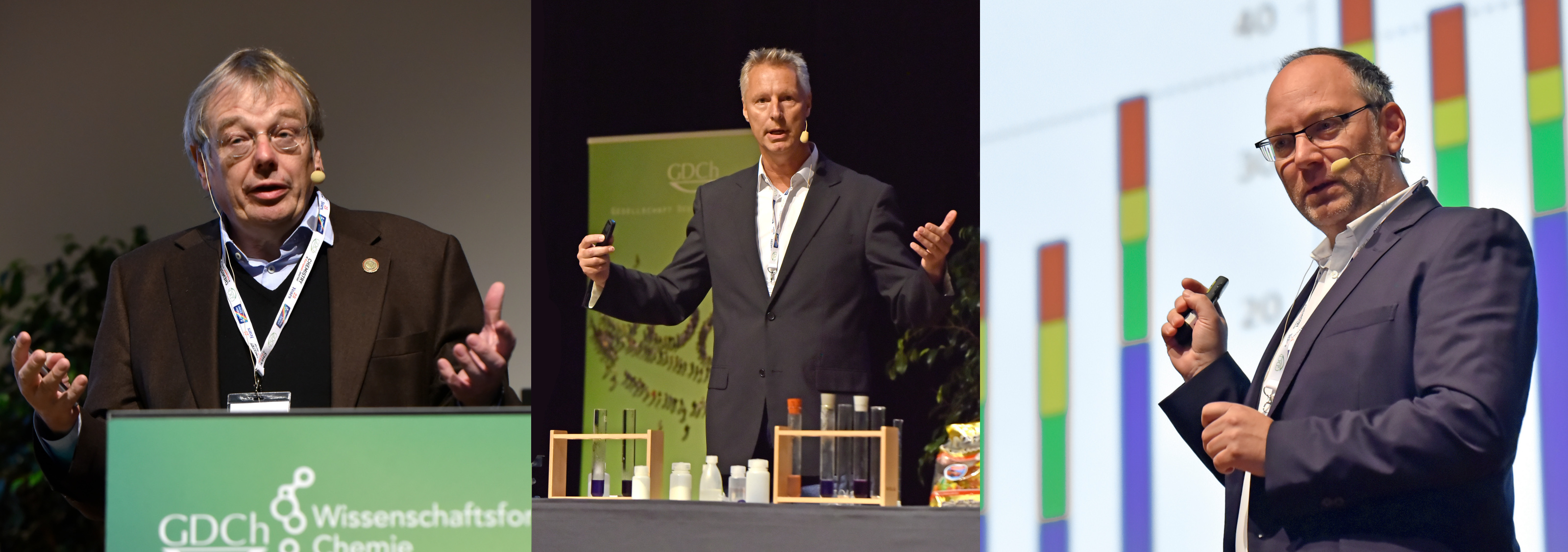
Figure 4. During their talks (from left to right) Professor Martin Möller, RWTH Aachen University (Can a Material Perform as an Engine), Professor Matthias Ducci, PH Karlsruhe, and Professor Bert Sels, Leuven Belgium (Refining Lignocellulose and the Role of Catalysis). (Photos: © GDCh/Christian Augustin)
The Periodic Table – The Work of Ages
Mendeljew’s periodic table of the elements reminds Professor Theodore Gray, Urbana, Illinois, USA, of cathedrals. Work on it continued for a very long time, and constructors did not see it once it was finished.
Alchemists already had developed an idea of what an element is: A substance that could always be recovered. They knew that lead and gold were elements. Henning Brand, searched as other alchemists did, for the “philosopher’s stone”, a substance which supposedly transformed base metals like lead into gold. In 1669, he discovered phosphorus in urine while searching for gold. Brand named the element cold fire; later it was named after the Greek word for “light-bearing” or “light-bearer.”
In 1869, Mendeleev knew 63 elements. Today, seven generations of researchers later, we know 118. As in the construction of cathedrals, there were problems with the periodic table. The existence of isotopes and radioactivity, for example, lead to temporary disturbances. Today, we know that the idea of the alchemists was not entirely wrong: “It turned out the alchemists were right: You can transform one element into another. You can convert lead to gold. It is just too expensive, and you need a nuclear reactor, which alchemists did not possess.”
To Theodore Gray, the periodic table is a collection of stories. Accompanied by many explosions and fires on the video screen, he fascinated his audience with a few of them. Taking these videos seems to have been associated with many adventures. To get the perfect picture of an explosion, Gray, for example, blew up most of his glassware [6].
Modern Raw Material Extraction
Professor Martin Bertau, TU Bergakademie Freiberg, gave a very critical lecture on modern raw material extraction. Three hundred years ago, the spectrum of technically used elements was manageable with C, Ca, and Fe in 1700 and C, Ca, Fe, Cu, Mn, Pb, Sn, and W in 1800. The focus was on building materials and everyday necessities as well as energy generation. With the onset of industrialization, this changed abruptly and today there is a technical application for almost every element. The “raw material storage smartphone” is one of the terms synonymous with this development.
Nevertheless, Martin Bertau warns, “The great hunger for raw materials is still to come”. The population development on Earth, the worldwide striving for prosperity according to the Western model, and the implementation of climate protection policy goals present the extraction of raw materials with their greatest challenge. “This increasingly complex situation is forcing us to optimize extraction processes and keep raw materials in the cycle”, Bertau said.
Even though the supply of raw materials to an economy is a national issue, the subject of raw materials needs to be considered globally. Industrial production is international and the extraction of raw materials is of global relevance due to its energy requirements and emissions. This also includes the extraction of raw materials in countries with lower environmental and safety standards than in the industrialized countries. At the same time, the battle for raw materials is already in full swing.
Like no other discipline, modern chemistry is in demand and in a position to provide answers to this complex situation. Methods and processes are needed to extract and recycle raw materials with the least possible impact on the environment. Martin Bertau said the focus will be on networked, holistic, low-emission processes that come very close to the zero-waste principle. These include the use of CO2 as raw material and the valorization of residual materials. And there is a need for processes that guarantee genuine recycling instead of downcycling, Bertau predicts [7].
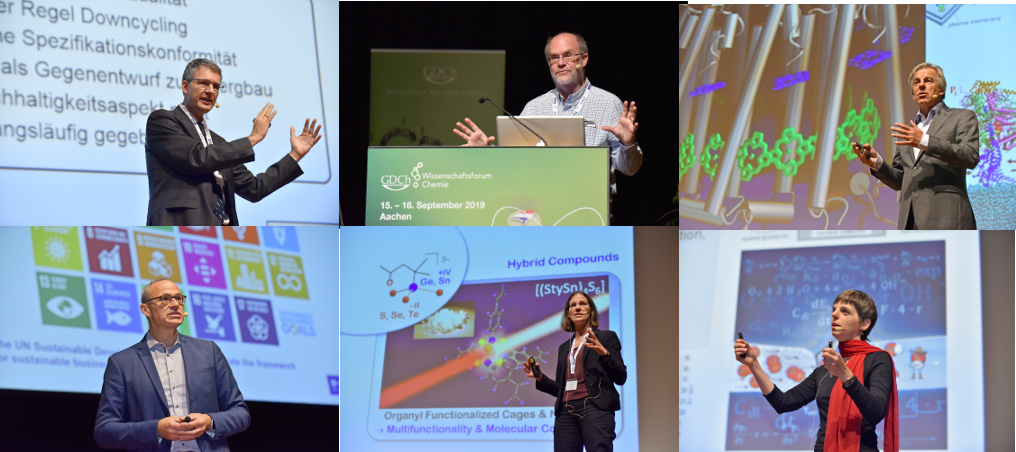
Figure 5. During their talks (left to right): Professor Martin Bertau, TU Bergakademie Freiberg, Professor Theodore Gray, Urbana, Illinois, USA, Professor E. B. “Bert” Meijer, Eindhoven University of Technology, The Netherlands (Functional Supramolecular Materials and Systems), Dr. Peter Eckes, Research Triangle Park (RTP), NC, USA (Chemical Research for a Sustainable Future), Professor Stephanie Dehnen, University of Marburg (Multinary Clusters – Between Molecular Aesthetics and Macroscopic Functionality), Professor Ulrike Krewer, Technische Universität Braunschweig (Understanding of kinetics as a catalyst for a future electrochemical power supply). (Photos: © GDCh/Christian Augustin)
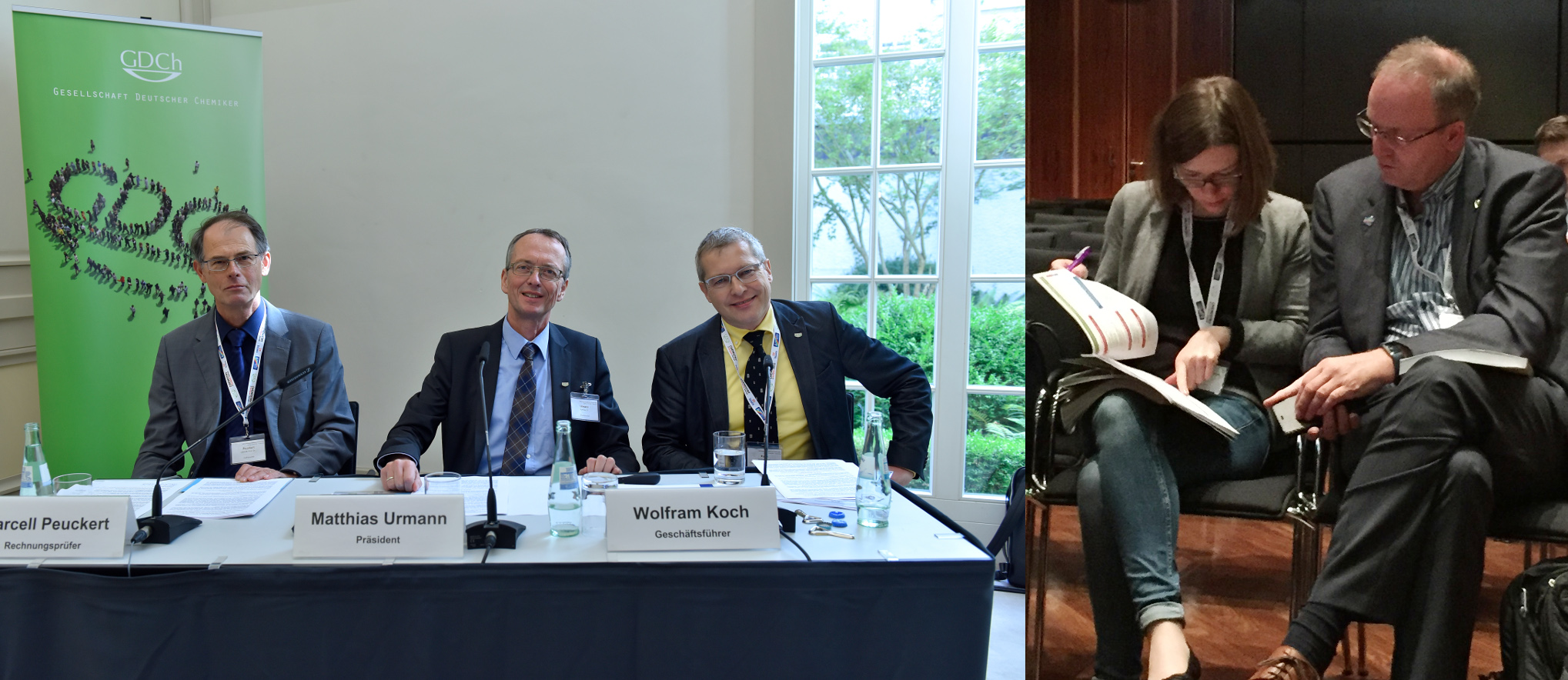
Figure 6. During the GDCh members meeting: Professor Marcell Peuckert, GDCh accountant and University of Gießen, Dr. Matthias Urmann, GDCh President, Professor Wolfgang Koch, GDCh Managing Director (left; Photo: © GDCh/Christian Augustin). Dr. Neville Compton and Dr. Nathalie Weickgenannt, Editor-in-Chief and Deputy Editor of Angewandte Chemie, exchange ideas about the lectures (right; Photo: © Vera Koester).
Selected Awards
Traditionally, many prizes are awarded at the WiFo. To name a few of the awardees: Professor Dieter Vogt, Technical University Dortmund, received the 2019 Wöhler Prize for Sustainable Chemistry from the GDCh for his work on homogeneous catalysis, which contributes to the development of sustainable methods in chemistry. Professor Frank Würthner, University of Würzburg, received the 2019 Adolf von Baeyer Memorial Medal from the GDCh for his outstanding work on supramolecular polymers. Professor Wolfgang Bensch, University of Kiel, was awarded the 2019 Wilhelm Klemm Prize by the GDCh for his innovative work on chalcogenides and his dedication to solid-state chemistry and materials research.
Professor Martin Winter, Westfälische Wilhelms University Münster, received the 2019 Arfvedson-Schlenk Prize for his research on the structure, stability, and kinetics of lithium-ion batteries and his special commitment to German battery research. Martin Winter is considered a pioneer in lithium-based intermetallic anode materials such as Li-Si and Li-Sn. Professor Walter Jansen, Emeritus Carl-von-Ossietzky University Oldenburg, received the 2019 Heinz-Schmidkunz Prize for his concepts for chemistry education of electrochemistry, his problem-oriented teaching methods, and the Chemol project. It brings chemistry and natural sciences to children of primary school age. Within this framework, an extensive collection of experiments for practical science teaching was created. Jansen was the founding editor of ChemKon, a chemistry education journal owned by the GDCh.
Klaus Müllen Encourages the Young Chemists
Professor Klaus Müllen, Emeritus at the Max Planck Institute for Polymer Research, Mainz, received the 2019 Karl Ziegler Prize from the GDCh and the Karl Ziegler Foundation. The award is one of the highest honors in the field of chemistry in Germany. Klaus Müllen received the prize for his lifelong service as an advocate for chemistry and his outstanding research, which combines organic and polymer chemistry.
Klaus Müllen, in a short speech, encouraged everyone to engage in volunteer work. “Since we as chemists continue to be viewed in a very skeptical, volunteer work is all the more important.” In addition, he encouraged the young chemists to be courageous and to break new ground. The most important virtue, according to Klaus Müllen, is learning to deal with disappointments in research. When he was young, at conferences he used to think: “Why is everyone so smart and why does so much go wrong for us?”. Scientific breakthroughs take time. He compared it to football. You have to practice continuously, you need many attempts, you win, but just as often you lose, you don’t win alone, you are always compared to someone. He wished everyone great victories and lots of fun in their research.
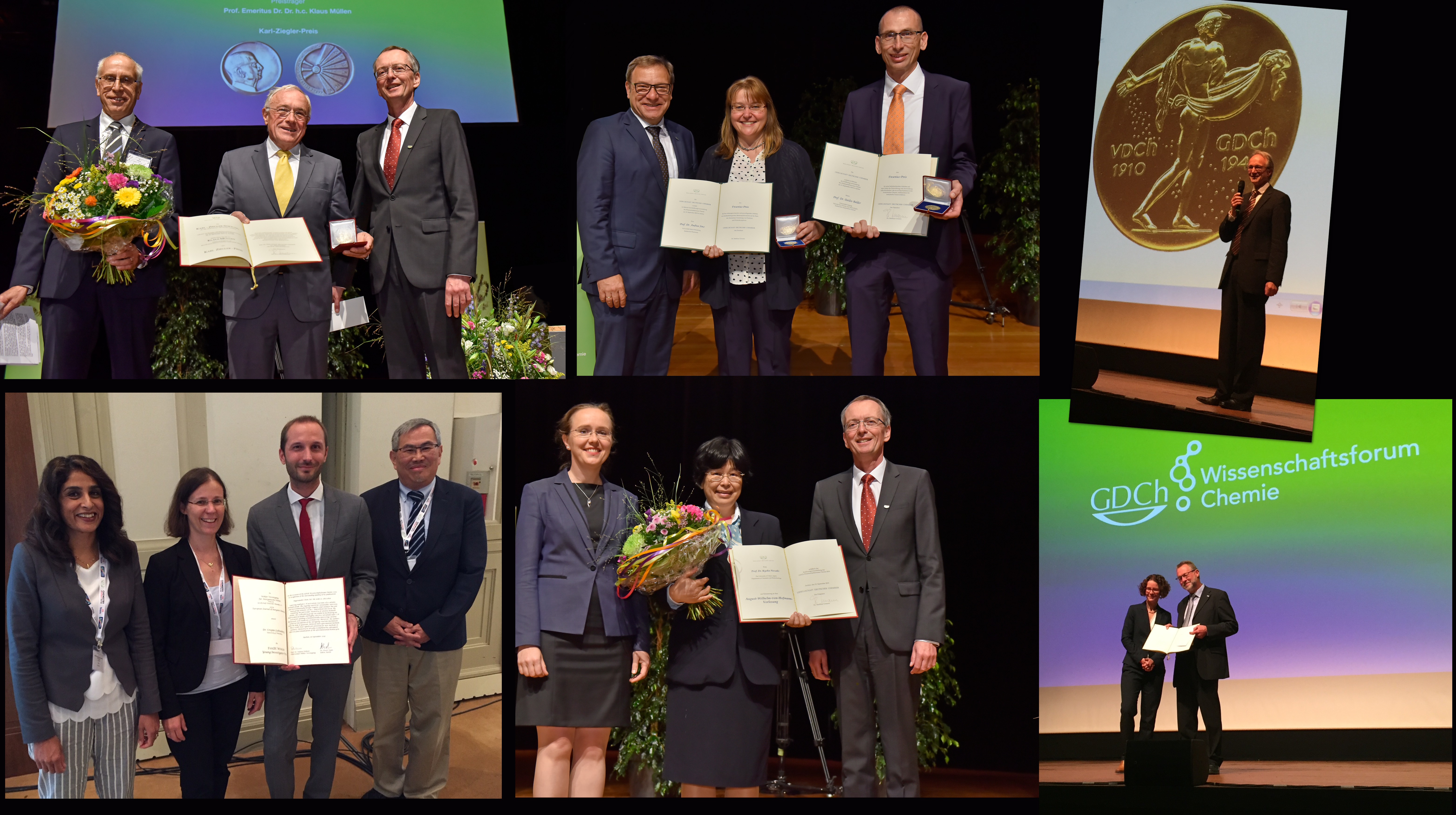
Figure 7. Some of the awardees. From top left to bottom right:
Dr. Dieter Jahn, laudator, Professor Klaus Müllen, Karl Ziegler Prize awardee and Dr. Urmann (Photo: © GDCh/Christian Augustin). Dr. Joachim R. Richert, laudator, Professors Andrea Sinz and Detlev Belder, Fresenius Prize for Analytical Chemistry awardees (Photo: © GDCh/Christian Augustin). Professor Frank Würthner, Adolf von Baeyer awardee (Photo © Vera Koester).
Dr. Preeti Vashi, Editor-in-Chief European Journal of Inorganic Chemistry, Wiley-VCH, Weinheim, Professor Stephanie Dehnen, Chair of GDCh’s Woehler Vereinigung and University of Marburg, Dr. Crispin Lichtenberg, EurJIC-Woehler Young Investigator Prize awardee and University of Würzburg, Professor Jun Okuda, laudator and RWTH University Aachen.
Professor Anke Krüger, laudator, Professor Kyoko Nozaki, August Wilhelm von Hofmann lecture laureate and University of Tokyo, Japan, Dr. Urmann (Photo: © GDCh/Christian Augustin). Professor Regina Palkovits, laudator and RWTH University Aachen, and Professor Dieter Vogt, Wöhler Prize for Sustainable Chemistry awardee. (Photo: © Vera Koester).
Fresenius Prize for Analytical Chemistry
The Fresenius Prize for Analytical Chemistry, the highest honor of the GDCh in this field, was awarded equally to Professor Detlev Belder, University of Leipzig, and Professor Andrea Sinz, Martin Luther University of Halle-Wittenberg. Instead of a laudatory speech, Dr. Joachim R. Richert, Chairman of the Analytical Chemistry Division and BASF SE, Ludwigshafen, interviewed the prizewinners, to find out what makes the two awardees the most successful analytic chemists in Germany. Andrea Sinz received the award for her trendsetting and fundamental structural-biological mass spectrometry based on the chemical cross-linking of proteins and protein complexes. Detlev Belder was honored for his pioneering work in the development and application of microfluidic lab-on-a-chip systems in analytical chemistry, in particular for analytical separation methods.
New Strategy for Bismuth(III)‐Mediated CH Activation
Dr. Crispin Lichtenberg, University of Würzburg, was awarded the EurJIC-Woehler Young Investigator Prize 2019. This award honors a young investigator in the field of Inorganic Chemistry for an excellent scientific publication in which the candidate is a correspondence author. Crispin Lichtenberg was awarded the prize for his paper on “Double CH Activation of a Masked Cationic Bismuth Amide” [8], in which he and his team introduced cationization as a new strategy for bismuth(III)‐mediated CH activation. A (masked) cationic bismuth compound was used for the highly selective, stepwise double CH activation of diphenyl amide, (NPh2)−. Simple procedures for the straightforward functionalization of the activated positions were presented, and mechanistic aspects of these transformations were explained.
Crispin Lichtenberg told ChemistryViews.org, that he believes that “bismuth and the complexes of this element show some intrinsic properties that are very interesting for applications in synthesis and catalysis. And finding these properties and making them usable for the community is what we are into.” He continues that he and his group “make certain types of reactions accessible that are interesting not only for the inorganic community but also for other communities. In this specific case, I could imagine that organic and macromolecular chemists may also be interested in that because we can not only make bismuth complexes with very unusual properties but we aim to also make these usable for organic synthesis and polymer science.”
Figure 8. Lanyards and #chemquackers. Photo: © Vera Koester
Figure 9. Complex and fascinating chemical structures build with commercially available toys by Dr. Aleksandar Kondinski, KU Leuven, Belgium, for teaching and learning [9]. Photo: © Vera Koester
Figure 10. Impressions of the trade exhibition. Photo: © Vera Koester
Figure 11. Impressions of the poster party and posters. Photo: © Vera Koester
Figure 12. Wiley-VCH offered the opportunity to take a picture with your favorite element (left). At the booths of Wiley-VCH and the GDCh, there was champagne and cake to celebrate the long and manifold relationships between the two organizations. Photos: © Vera Koester
Selected Satellite Events
Experiment Future – Value Thinking in Chemistry
In 2017, the event format “Experiment Future – Value Thinking in Chemistry” was introduced by Professor Thisbe K. Lindhorst, Kiel University, Germany [10]. It invites participants to discuss important future issues with high-ranking personalities from research, business, and science communication. The event format features a mixture of short lectures, short interviews, and panel discussions, as well as various workshops involving all participants. Social topics, which are strongly influenced by chemistry, are discussed intensively and sometimes also controversially with all participants and recommendations for actions are given to the GDCh. This time, the overall topic was “Knowing and Not Knowing”.
Suggestions and ideas for the work of the GDCh were collected from the discussions. Matthias Urmann promised that the GDCh Board will select the most important topics to decide what can be implemented. Examples included supporting stronger networking of chemistry didactics with professors from research, offering event formats like the Experiment Future also in the local GDCh groups and opening these also to non-chemists, giving young people more opportunity in communication processes at the WiFo, or how to find lateral thinkers.
Chemistry Slam
The 3rd ChemistrySlam was organized by the GDCh Working Group ‘Chemistry and Society’ and the Young Chemist Forum (JungChemiker Forum) Aachen. The slam demonstrated how easy to understand, exciting, and funny chemistry can be. The slammers presented their topic in seven minutes in a simple and entertaining way and the audience determined the winners. Dr. ChemSlam 2019 is Marlene Böldl, pictured below. She convinced with her slam about bio-plastics.
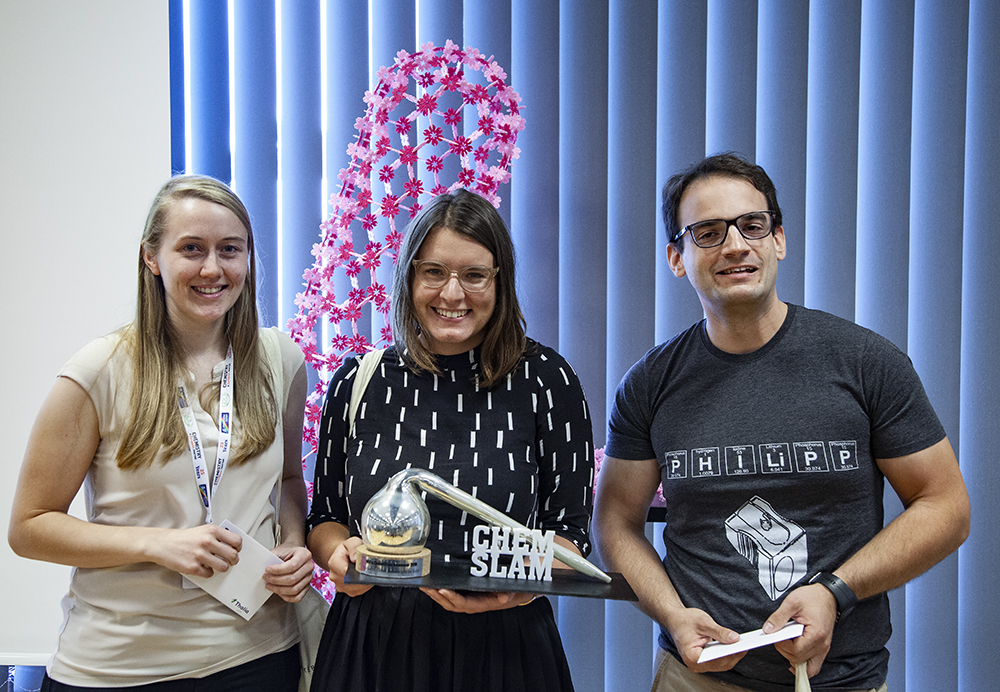
Figure 13. Winners of the Chemistry Slam: (left to right) Lucy Dittrich (3rd), Marlene Böldl (1st), and Philipp Spitzer (2nd). (Photo © Wolfgang Gerhartz)
Outlook
Professor Peter Schreiner, University of Gießen, has been elected as President of the GDCh for 2020/2021. Professor Stephanie Dehnen, University of Marburg, and Dr. Carla Seidel, BASF SE, Ludwigshafen, have been elected Vice Presidents for 2020/2021 [11].
► In 2021, the WiFo will take place in Munich, Germany. (5.-8. September)
References
[1] Code of Conduct, in Satzung und Verhaltenskodex der GDCh 2014.
[2] Matthias Ducci, Azofarbstoffe in Gummibärchen – aus Blau wird Gelb (Azo Dyes in Gummy Bears – Blue Becomes Yellow), Nachr. Chem. 2017, 65(9), 924–927. https://doi.org/10.1002/nadc.20174065156 (in German)
[3] S. Zajonc, A. Schwarz, M. Ducci, Chemkon 2015, 22, 111–118.
[4] C. Herriger, W. Schmitz, S. Zajonc, M. Ducci, Chemkon 2012, 19, 59–66.
[5] Christian Remenyi, Gummy Bears and Their Colors, ChemViews Mag. 2018.
[6] Theodore Gray, Elements: A Visual Exploration of Every Known Atom in the Universe, Black Dog & Leventhal, 2009. ISBN-13: 978-1579128142
[7] Martin Bertau, Die zukünftige Sicherung der Rohstoffbasis (Future Securing of the Raw Materials Base), Chem. Ing. Tech. 2018, 90, 1647–1657. https://doi.org/10.1002/cite.201800052
[8] Benedikt Ritschel, Jordi Poater, Hannah Dengel, F. Matthias Bickelhaupt, Crispin Lichtenberg, Double CH Activation of a Masked Cationic Bismuth Amide, Angew. Chem. Int. Ed. 2019. https://doi.org/10.1002/anie.201712725
[9] Vera Koester, Aleksandar Kondinski, Constructing Models for Teaching and Learning, ChemViews Mag. 2019. https://doi.org/10.1002/chemv.201900021
[10] Vera Koester, Thisbe K, Lindhorst, Taking Responsibility for Society, ChemViews Mag. 2017. https://doi.org/10.1002/chemv.201700056
[11] Peter R. Schreiner wird neuer Präsident, Pressemitteilung Gesellschaft Deutscher Chemiker 27/19, 24. September 2019.
[12] Tim Gatzenmeier, Manuel van Gemmeren*, Youwei Xie, Denis Höfler, Markus Leutzsch, Benjamin List, Asymmetric Lewis acid organocatalysis of the Diels–Alder reaction by a silylated C–H acid, Science 2016, 351(6276),949–952. https://doi.org/10.1126/science.aae0010
Also of Interest
- Event Calendar: GDCh-Wissenschaftsforum Chemie 2019 (WiFo 2019)
- Ausführliche Tageszusammenfassungen, Summary of each day by the GDCh (in German)
- Sustainable Chemistry Award for Dieter Vogt, ChemViews Mag. 2019
Researcher from the Technical University Dortmund, Germany, receives the Wöhler Prize for Sustainable Chemistry - Adolf von Baeyer Memorial Medal 2019, ChemViews Mag. 2019
Organic chemistry award for Frank Würthner, University of Würzburg, Germany - Wilhelm Klemm Prize for Wolfgang Bensch, ChemViews Mag. 2019
Inorganic chemistry award for researcher from the University of Kiel, Germany - Karl Ziegler Prize for Klaus Müllen, ChemViews Mag. 2019
One of the highest German honors in chemistry for polymer and materials researcher
